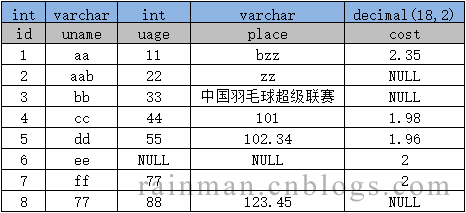
In concatenations of two different datatypes, Oracle Database returns the datatype that in a lossless conversion. Therefore, if one of the arguments is a LOB, then the returned value is a LOB. If one of the arguments is a national datatype, then the returned value is a national datatype. Although Oracle treats zero-length character strings as nulls, concatenating a zero-length character string with another operand always in the other operan so null can result only from the concatenation of two null strings.
However, this may not continue to be true in future versions of Oracle Database. What is the string concatenation operator in Oracle SQL? Are there any interesting features I should be careful of? Oracle CONCAT function : The Oracle CONCAT () function returns the result (a string) of concatenating two string values. I need to Concatenate a Varchar and int in T-SQL , ! Zeichen), sofern keiner der Parameter vom Typ „nvarchar“ mit beliebiger Länge ist.
In diesem Fall gibt CONCAT ein Ergebnis vom Typ nvarchar(max) zurück. The WM_ CONCAT function described above is an example of a user-defined aggregate function that Oracle have already created for you. Thanks to Kim Berg Hansen for some corrections in comments. Long DataType Concat with VarChar ? The AskTOM team is taking a break over the holiday season. You can still search the repository of over 20questions answered.
Thanks for being a member of the AskTOM community. How about modifying CAST expression as CAST(DAY(Current_Date) AS VARCHAR (2)). VARCHAR has an additional overhead but it would remove the possibility of trailing spaces. Also, do not forget about the size specification. Zum Beispiel kann ein CONCAT auf einem CLOB und NCLOB ergibt eine NCLOB.
Ein CONCAT auf einer Zahl und einem varcharführt zu einem varcharusw. I have learnt from this page that dbms_sql is better to dynamically execute CLOB fields and i want to know if there is a way to return dynamic cursor instead of dbms_sql cursor in oracle 10gR2. I see that in Oracle 11g we have to_refcursor function. Sie können dieses Verhalten jedoch ändern, indem Sie die CONCAT _NULL_YIELDS_NULL-Einstellung für die aktuelle Sitzung ändern.

However, you can change this behavior by changing the setting of CONCAT _NULL_YIELDS_NULL for the current session. Weitere Informationen unter SET CONCAT _NULL_YIELDS_NULL (Transact-SQL). Concatenate int and varchar is a usual problem that we face in SQL scripting and the solution is easily available over the web.
Let me show you the issue that we generally face when we concatenate int and varchar. Content reproduced on this site is the property of the respective copyright holders. It is not reviewed in advance by Oracle and does not necessarily represent the opinion of Oracle or any other party. In Oracle existieren drei Datentypen für die Speicherung der Zeichenketten – CHAR, VARCHAR und VARCHAR2. Jeder der sich zum ersten mal mit der Oracle Datenbank auseinader setzen möchte, wird sich mit sicherheit fragen, was der Unterschied zwischen den Datentypen ist und in welchem Fall welches Datentyp verwendet werden sollte.

Answer: Oracle Guru Laurent Schneider has this to add about the use of CAST and wm_ concat : Regarding the returned by wm_ concat , The use of CAST does indeed resize or expand to the specified length. As for using varcharwith the wm_ concat , it does not right pad with blank space.
Keine Kommentare:
Kommentar veröffentlichen
Hinweis: Nur ein Mitglied dieses Blogs kann Kommentare posten.